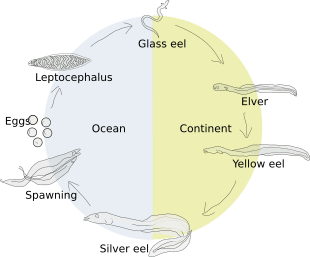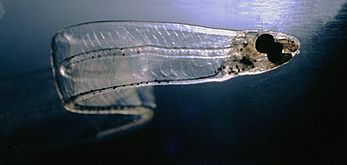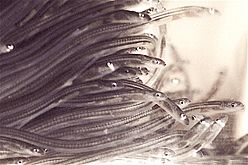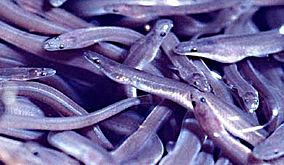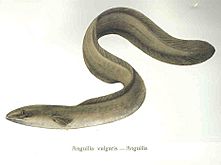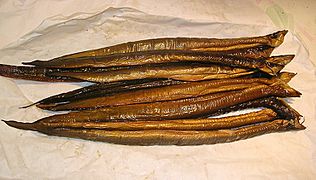Eel facts for kids
Quick facts for kids True eels |
|
|---|---|
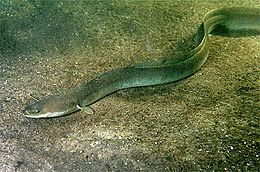 |
|
| European eel, Anguilla anguilla | |
| Scientific classification | |
| Kingdom: | |
| Phylum: | |
| Class: | |
| Order: |
Anguilliformes
|
| Suborders | |
|
Anguilloidei |
|
True eels are a type of fish with long, thin bodies, much like snakes. They are part of a group of fish called teleosts. Adult eels can be as short as 10 centimeters (about 4 inches) or as long as 3 meters (nearly 10 feet). Their size depends on their species. The largest eels can weigh up to 65 kilograms (about 143 pounds).
Eels have fewer fins than most other fish. They do not have the fins usually found on a fish's belly or chest. Their back and anal fins are long and often connect to their tail fin. These fins do not have any sharp spines.
The bones that support their shoulders are separate from their skull. Eels either have very smooth scales or no scales at all.
Eels hatch from eggs. Baby eels, called leptocephalus (which means "thin head" in Greek), are flat and see-through. A young eel is known as an elver. For a long time, people didn't know where eels came from. This was because baby eels look so different from adult eels. People even thought they were a different species!
Most eels like to live in the shallow parts of the ocean. They often live at the bottom, sometimes hiding in holes. Eels from the Anguillidae family travel to fresh water to live there. Other eels, like those in the Nemichthyidae family, swim about 500 meters (1,640 feet) below the ocean surface. Some eels, like those in the Synaphobranchidae family, live even deeper, up to 4,000 meters (13,123 feet) below the surface.
Catching eels with nets by hand is the only legal way to catch them in England. People have been doing this for thousands of years on the River Parrett and River Severn.
Most eels are predators. This means they hunt other animals for their prey.
Contents
What are Eels?
True eels belong to a scientific group called an order. This order is named Anguilliformes, which means "eel-shaped" in Latin.
This order is divided into 4 smaller groups called suborders: Anguilloidei, Nemichthyoidei, Congroidei, and Synaphobranchoidei.
These suborders are then split into 19 families. These families are divided into 110 genera. Finally, the genera are divided into different species. In total, there are about 400 known species of eels!
How Eels Look and Move
Eels are long, thin fish. The smallest, the one-jawed eel (Monognathus ahlstromi), is only about 5 centimeters (2 inches) long. The longest, the slender giant moray, can reach 4 meters (13 feet). Adult eels can weigh from 30 grams (1 ounce) to over 25 kilograms (55 pounds).
Eels do not have pelvic fins (fins on their belly). Many species also lack pectoral fins (fins on their sides, like arms). Their dorsal (back) and anal fins are joined with their caudal (tail) fin. This forms one long ribbon-like fin along most of their body. Eels swim by making wave-like movements with their bodies. They can even swim backwards by reversing these waves.
Where Eels Live
Most eels live in shallow ocean waters. They often burrow into sand, mud, or hide among rocks. Many eel species are nocturnal, meaning they are active at night. This is why you rarely see them during the day. Sometimes, many eels live together in holes, which are called "eel pits."
Some eels live in deeper waters, on the edges of continents. They can be found in depths up to 4,000 meters (13,123 feet). Only members of the Anguilla group regularly live in fresh water. However, even these eels return to the sea to lay their eggs.
The heaviest true eel is the European conger. It can grow up to 3 meters (10 feet) long and weigh 110 kilograms (240 pounds). Other eels, like the slender giant moray, are longer (up to 4 meters or 13 feet) but do not weigh as much.
Life Cycle of Eels
Eels start their lives as flat, clear larvae called leptocephali. These tiny eel larvae float in the ocean's surface waters. They eat "marine snow," which are small bits of floating food.
After a while, eel larvae change into "glass eels." They then become "elvers" before finding their homes as young and adult eels. Freshwater elvers travel upstream in rivers. They even climb over things like weirs, dam walls, and natural waterfalls.
Long ago, Lady Colin Campbell found a way to help eels. She improved eel fishing at Ballisodare by hanging loose grass ladders over barriers. This helped the elvers climb up the river.
Eels and People
Eels are eaten in many parts of the world. Freshwater eels (called unagi) and marine eels (like conger eels, called anago) are popular in Japanese cuisine. Dishes like unadon are well-liked but can be expensive. Eels are also very popular in Chinese cuisine and are cooked in many ways. In Hong Kong, eel prices can be very high.
The European eel and other freshwater eels are eaten in Europe, the United States, and other places. A traditional food in east London is jellied eels. However, fewer people eat them now than before World War II.
In northern Spain, a special dish called angulas is made from elvers. These young eels are sautéed in olive oil with garlic. Elvers can be very expensive, sometimes costing up to 1000 euro per kilogram. The New Zealand longfin eel is a traditional food for the Māori people in New Zealand.
In Italian cuisine, eels from the Valli di Comacchio (a swampy area) are highly valued. Eels from Bolsena Lake and pond eels from Cabras, Sardinia are also prized. In northern Germany, the Netherlands, the Czech Republic, Poland, Denmark, and Sweden, smoked eel is considered a special treat.
Elvers, often fried, used to be a cheap meal in the United Kingdom. But in the 1990s, their numbers dropped sharply across Europe. Now, they are not just a special food, but the most expensive seafood in the UK.
Eels, especially the moray eel, are also popular in home aquariums.
Important Safety Note
Eel blood is poisonous to humans and other mammals. However, cooking the eel or digesting it destroys the harmful protein. So, cooked eel is safe to eat. A scientist named Charles Robert Richet used a toxin from eel blood in his research. This research helped him discover anaphylaxis, a severe allergic reaction.
Eelskin Leather
You might have heard of eelskin leather. It is very smooth and super strong. But here's a fun fact: it doesn't actually come from eels! It comes from the Pacific hagfish. This is a jawless fish that is also known as the "slime eel."
Eels in Culture
The large lake of Almere, which existed long ago in the Netherlands, got its name from the eels living there. The Dutch word for eel is "aal" or "ael," so "ael mere" meant "eel lake." The name is still used today for the new town of Almere in Flevoland.
The sight of Elvers swimming upstream in the Thames during spring was once called "eel fare." The word 'elver' is thought to come from this old term.
On the French Polynesian island of Huahine, there's a famous attraction. It's a bridge over a stream where 3- to 6-foot-long eels live. The local people consider these eels sacred.
Sustainable Eel Consumption
In 2010, Greenpeace International added the European eel, Japanese eel, and American eel to its "seafood red list." This means these eel species are at risk. Japan eats more than 70% of all eels caught worldwide.
-
Gerookte paling (Dutch for smoked eel)
Images for kids
-
The European conger is the heaviest of all eels.
-
Positioning eel traps in Inle Lake (Myanmar).
-
Anguilla anguilla, an Anguillidae
-
Conger, a Congridae
-
Moringua edwardsi, a Moringuidae
See also
 In Spanish: Anguiliformes para niños
In Spanish: Anguiliformes para niños


